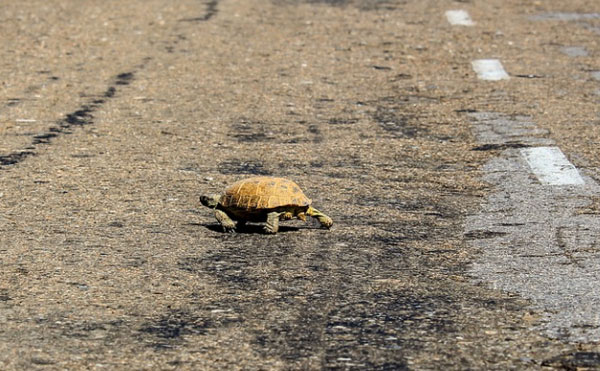Unlike the infamous chicken of many riddles, turtles actually cross roads not just to get to the other side, but because they actually have someplace to go.
It’s common to see turtles crossing roads in Ohio from April through October. Considering we have about 10 species of turtles in Ohio, eight of which can be found in Muskingum County, it’s likely you will encounter one. Road mortality is a major factor in turtle population declines throughout the United States. Helping these animals cross safely is an important and valuable contribution to the preservation of North America’s turtles.
Because much of the habitat necessary to turtle survival is fragmented by roads, just getting to food, water, and fellow turtles requires turtles to cross roads. Turtles often cross roads in the morning, especially after rain. They will also cross when looking for territory to call their own, in search of water during periods of drought, and in the fall they a looking for somewhere to hibernate.
The box turtle is the only completely terrestrial turtle in Ohio and therefore are more commonly seen crossing roads; however, aquatic turtles including Painted turtles and Snapping turtles are often crossing to find a safe place to lay eggs. It is especially vital to help these females with eggs safely cross in order to preserve regional populations. So, what can you do to safely help a turtle avoid the perils of road travel?
Don’t put yourself or others in danger. Simply pulling off the road and turning on your hazards may alert other drivers to slow down. Pay attention to your surroundings and traffic. Make sure other drivers see you before you step out of your vehicle.
Don’t pick turtles up by the tail! Box turtles do not bite and can be safely picked up around the shell, but snapping turtles do bite and can be dangerous. A turtle can be safely picked up by the back of the shell, or with larger, more aggressive turtles, I generally push them across with my foot on the back of their shell. A little road rash is far better than a crushed shell. Be aware the turtle is afraid of you and may empty their bladder, hold them away from your body and be sure not to drop the turtle.
Allow turtles to cross unassisted if there is no oncoming traffic. Just “walk” the turtle across the road.
Always put the turtle off the road in the direction they are heading. They are going that way for a reason, and if placed on the wrong side, they will just turn around and walk back into the road. Remember the phrase “if you care, leave it there.”
Never take the turtle home with you. It’s illegal in Ohio now to remove a box turtle from the wild. Their populations are declining at an alarming rate and one of the reasons is people taking them for pets. Turtles live over 100 years, don’t do well in captivity, and generally do not make good pets, especially for children. Please, do not take animals out of the wild for pets.
Relocating wildlife, especially turtles, is not a good idea either. All animals have a territory where they know where the resources they need to survive are found. Removing them from their “home” and relocating them is most often a death sentence. Relocated animals do not know where their food, water, and shelter are found and are vulnerable to predation from other animals.
If you happen to find an injured turtle, safely put it in a box and note the location where you found it, then contact a local licensed wildlife rehabilitator. There is a list by county on the Ohio Division of Wildlife website, or call our office at 740-454-2027.
Snap a quick picture of the turtle with your phone and send it to our survey, the Muskingum County Reptile and Amphibian Survey on Facebook, or nicole.hafer@muskingumswcd.org.
Turtles and other reptiles are truly at the mercy of drivers when they are forced to cross roads. It is out of necessity that these animals are on the road and helping them across is an easy thing everyone can do to help protect reptiles in Ohio. So when you are driving this summer and fall, please watch for turtles on the road and help them cross. The turtles will thank you.
Our annual berry plant sale is going on now through April, 26th. | Order Online Today! • Our annual fish sale is going on now through April, 26th. Pickup day is May 7th. | Order Online Today! • We will be on Live At Noon on Monday, April 29, 2024 with NRCS.
